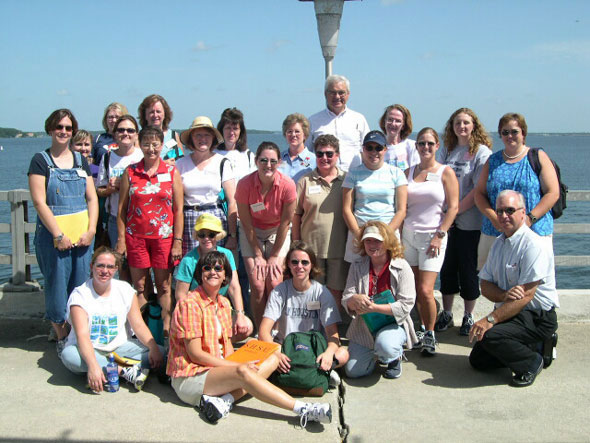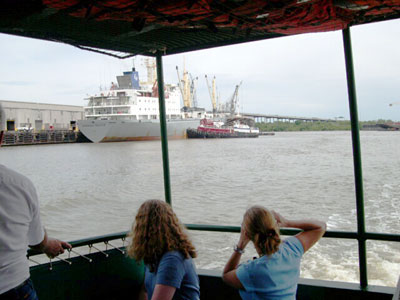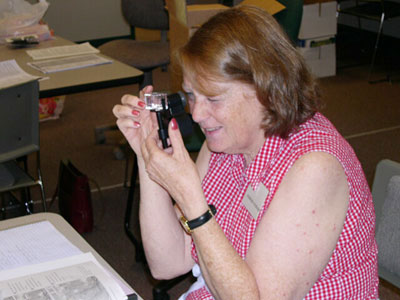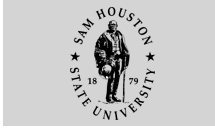Course Educates Teachers On Environmental Issues
 |
| Graduate students got a hands-on learning
experience by visiting such places as the Conroe Dam as
part of a Teaching Environmental Sciences class, a 10-day
course funded by a $20,000 grant from the Environmental
Protection Agency through the Texas Commission on Environmental
Quality. |
Teaching teachers has been a focus of Sam Houston State since
its establishment over 125 years ago.
Today, the curriculum and instruction department has taken
teaching teachers to a more ‘hands-on’ level with
its 10-day Teaching Environmental Sciences graduate course.
Through this program, funded by the Environmental Protection
Agency through the Texas Commission on Environmental Quality,
local and area teachers spanning all grade levels were introduced
to the basic principals in environmental science by touring
facilities that deal with those issues on a daily basis.
This year, the third year SHSU has sponsored the program,
a record 20 teachers met at the University Center to participate
in the program, according to Terry Contant, assistant professor
of curriculum and instruction.
“The course is really designed to immerse the participants
in environmental issues in the community, and we visit utilities,
industries and governmental agencies that deal with air, water,
waste or pollution issues,” Contant said. “They
(TCEQ) fund the program at 20 universities, and the idea is
that you’ll go to the one that’s near you because
we go to places of environmental interest in the area.”
The group, under the direction of Contant and coordinator
for elementary education graduate studies Margaret Hammer
along with environmental science professor James DeShaw, visited
approximately 15 different agencies in Houston, Conroe, The
Woodlands and locally. Some of these places included the Entergy
power plant in Willis, Port of Houston, waste-water treatment
facilities in Conroe and Houston, Texas Forest Services at
Jones State Forest and Byrd Automotive, among many others.
“We were very busy,” Contant said.
 |
| Students also participated in a tour
of the Port of Houston (above) and looking through discovery
scopes during the TES class. |
 |
While visiting these places, the participants learned about
water quality testing, even testing local ponds and streams
themselves; the disposal of industrial wastes; composting
and doing a mosquito study; household hazardous waste; emissions
testing; and air quality monitoring.
“The goal is to inform teachers so they can better
inform their students about the environmental issues in the
community,” Contant said. “But it’s not
just looking from the environmentalist side or the industry
side; it’s trying to give them a balanced view.”
That goal was achieved, according to the positive feedback
from evaluation forms.
“This is science in action. This course has allowed
me to build life experiences to pass on to my students,”
one middle school teacher said. “I have had many science
courses, but none so interactive.
“This is how science should be taught: present the
information and allow students to draw their own conclusion,”
she said.
“Now I better understand the need for education in
environmental (and other) science. The younger we start this
education, the better,” a middle and high school teacher
wrote. “It really opened my eyes. I learned a lot.”
The course also gave teachers an opportunity to network,
another goal of the program because “it helps make that
education community connection, hence they’re learning
in a real-world context,” Contant said.
This too was also reflected in an evaluation form.
“I have always loved to teach science, using a hands-on
approach in my classroom even though my own background in
science is limited,” one elementary school teacher said.
“This class has given me so much information and resources
to use with my students that I feel even more capable of giving
my kids a deeper understanding of current environmental issues.
“The field trips were the best part of the program,
supplying me with people’s names and numbers that I
can use to support my classroom activities, as well as places
to which I can take my students for their own field experiences,”
she continued. “These are the kinds of things my students
will retain throughout school and life and things they will
build upon in the future.”
The recent passing in the State Legislature of a bill that
now requires high school students to take a fourth year of
science has reinforced the importance of learning more about
environmental issues, Contant said.
“It certainly shows the need for a program like this,”
she said. “Since that fourth year of science is probably
going to be geology-related, environmental science-related
or aquatic science, the general topics that we talked about
in this course are very helpful for teachers who are going
to be teaching some of these courses.”
“I think the most important thing is the chance that
the teachers get to network about education issues. They all
come away saying, ‘wow, I didn’t know there was
so much science right around me’ and realizing that
we take so much for granted, like you turn on the faucet and
you get the water, but who really thinks about what has to
happen to it?” Contant said. “They realize that
if they don’t know, their kids definitely don’t
know, and now they feel more confident that they can share
experiences.”
—END—
SHSU Media Contact: Jennifer
Gauntt
July 28, 2004
Please send comments, corrections, news tips to Today@Sam.edu.
|


